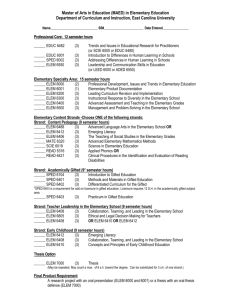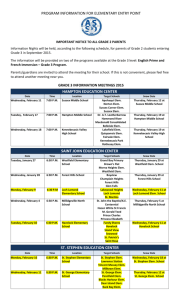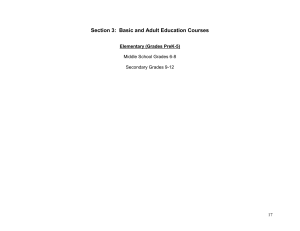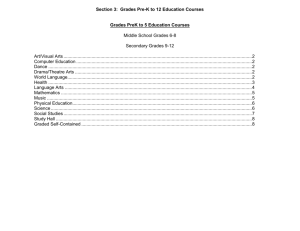2013 - Mandaluyong
advertisement
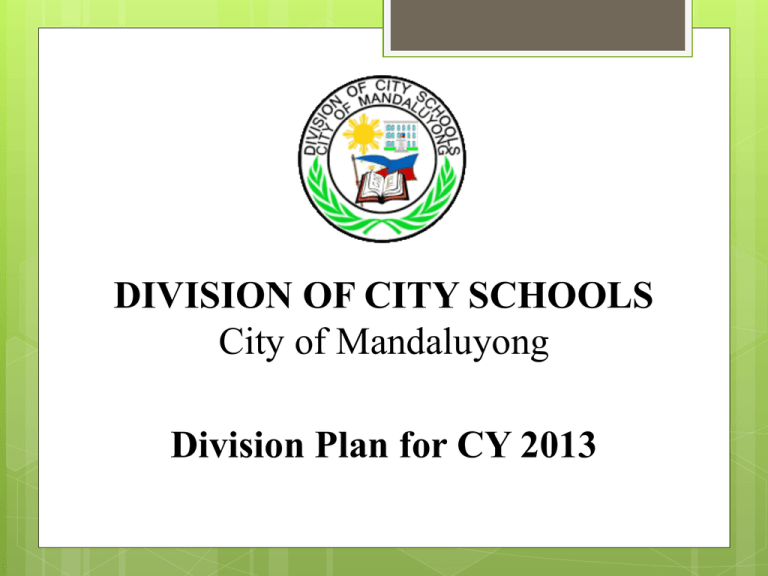
DIVISION OF CITY SCHOOLS City of Mandaluyong Division Plan for CY 2013 Type of Learners: -In-school: -33,859 Elementary/kinder -18,193 Secondary -174 Elem. SPED -21 Sec. SPED -3,027 Jose Fabella Memorial School (Special School) PROBLEM ANALYSIS ACCESS The secondary schools have a PCR of 64.67 which means that it does not meet R.A. 7880, schools with severe shortage of classrooms. The PCR of Elem. Schools is 54.15 which means that it does not meet the R.A. 7880 even with double shifting. GER (Elem.) has increased to 88.38 in 2011, however it is below the PDP target of 108.27%. GER (HS) has increased to 81.32 in 2011 , however it is below the PDP target of 86.86. Causes: • In the elementary the enrolment of the entire Division increased from 29,923 to 31,308 (2009-2011). • The enrolment for secondary schools increased from 16,270 to 17,857 (20092011) • A significant number of learners are enrolled in Private Schools and public schools in nearby divisions. • Transfer of learners to other public schools in nearby divisions and provinces Strategies: ACCESS • Request to the LGU Executives for the construction of medium rise building in Andres Bonifacio Integrated School and Jose Fabella Memorial School with buildable space. • Establishment of new School Annexes and Integrated Schools(1 elem. School and 1 Integrated School) • Conduct of school mapping to determine the school-age children. • Conduct of advocacy campaigns. QUALITY NAT for the last 3 Years (Elementary) SCHOOL YEAR MATHEMATICS ENGLISH SCIENCE FILIPINO HEKASI 46.64 56.35 50.91 69.95 56.11 2009-2010 53.35 55.15 49.55 71.79 59.04 2010-2011 46.54 53.66 52.64 61.30 51.17 2011-2012 MPS 55.99 57.77 53.06 80 2009-2010 60 2010-2011 40 2011-2012 20 0 • Increase/decrease of NAT MPS for elementary has been erratic in the last three years and way below the 75% National MPS target. QUALITY NAT for the last 3 Years (Secondary) School Year 2009-2010 2010-2011 2011-2012 MATHEMATICS 36.66 39.81 42.62 ENGLISH SCIENCE FILIPINO HEKASI 48.83 50.61 52.92 41.84 38.86 39.12 60.55 64.26 52.34 38.82 53.60 55.08 Critical Thinking MPS 45.34 49.46 51.65 48.81 70 60 50 40 30 2009-2010 20 2010-2011 10 2011-2012 0 • Increase/decrease of NAT MPS for secondary has been erratic in the last three years and way below the 75% National MPS target. QUALITY Causes: • Low reading performance as manifested in Phil-IRI results. • Teacher competence and capacity in managing different types of learners, innovative teaching style and strategies and curricular reforms. • Frequent suspension of classes due to heavy rains and typhoons • Existence of 2 shifts in all schools divisions in some schools divisions • Overlapping of extra-curricular activities across levels (attending trainings, workshops, celebrations, contests and meetings) • Frequent floodings and other geophysical problems in four schools. • Instructional supervisory style/strategies of School Heads and Supervisors. • Absence for Incentive and Award System for high performing learners Strategies: • • • • • • • • • • • • • QUALITY Roll out of PASBE - SBM ACCESs Implementation of K to12 Curriculum Implementation of strategic reading program in all schools. Identification of least mastered skills in NAT and provide appropriate learning activities for remediation/reinforcement Enhancement of Assessment/Testing Program of the Division and Schools Effective and efficient implementation of the K-12 Curriculum and other reforms Development of learning modules as a catch-up instruction during suspension of classes/ holding of make-up Saturday classes. Establishment of additional Special Science Elementary Schools Enhancement of library hubs, eClassrooms and ICT Integration in teaching. Creation of the learning resource portal (division and school websites) Regulation of Co-Curricular activities for learners and add-on tasks for teachers division heads, supervisors and principals. Capability building programs for instructional managers, school heads and teachers. Launching of Incentive and Award System for High Performing Learners EFFICIENCY • Elem. Schools have an insignificant drop-out rate for the last three year ranging from 0.67% to .0.49% whereas HS have a range of 5.95% to 2.13%. It can be noted that Elem. and HS have decreasing drop-out rate for the last three years. • Completion Rate for both elementary and secondary is below the PDP target. (93.8% elem. and 77.97% HS) • CSR for both elem. and HS is above the PDP targets. Causes: EFFICIENCY • Frequent floodings and other geophysical problems. • Teacher competence and capacity in managing different types of learners, innovative teaching style and strategies and curricular reforms • High cost of living resulting to irregular attendance of learners. • Parental involvement Strategies: • • • • • • • • • • • • • • EFFICIENCY Convergence with barangay and LGU officials. Launching of Eco-Savers Program Institutionalization of Greening Program. Implementation of Disaster and Risk Reduction Program. Capability building programs for teachers. Establishment of additional Open High Schools. Effective and efficient implementation of the K-12 Curriculum and other reforms Increasing the number of beneficiaries for the Feeding Program. Strict adherence to no collection policy and regulations on the requirements of school projects and other co-curricular activities. Institutionalization of parents support system/Guidance and counseling services to learners. Maintain Medical and Health Services to less privilege learners. Recommend additional beneficiaries for the 4Ps Program. Widen coverage of relevant ALS Livelihood Programs. Request for additional slots for GASTPE grantees GOVERNANCE • Absence of Plantilla Items for administrative and financial staff of the Division Office and Schools. • Full implementation of eBEIS, LIS. However, some ICT Support systems like LRMDS and AMS are still to be implemented. • Information dissemination process with in the division needs upgrading. • Absence of permanent ADR committees in the division and schools. • The division is only on the start up stage of the implementation Child Protection Policy. • School Audit Team is no yet in placed. • Preparation of Work and Financial Plan and Annual Procurement Plan is for compliance only • Incentive and award system for School heads, supervisors, teachers and non-teaching personnel needs enhancement. • Consultative and Support System between and among DepEd Officials, Local School Board and Congressional Office is very evident. Causes: • • • • • • • • • GOVERNANCE Division office has no authority to create and fill plantilla items Continuing support funds for internet connections not sustained LRMDS and AMS implementation is still on process. Resistance to change and slow adaptability of division and school officials and personnel ICT-enhanced processes. Low level of awareness on ADR law and processes Central Office had just released the DepEd Order on Child Protection Policy Low level of awareness on the significance of School Audit Teams Low level of expertise in the preparation of Work and Financial Plan and Annual Procurement Plan Incentive and award system is not well publicized Strategies: GOVERNANCE • Wait patiently for the approval of the Rationalization Plan • Request authority to fill for vacant non-teaching items • Include allocation of the salaries of Guards/ Utility Workers / Clerks of the division office and schools in the SEF budget. • Follow strictly the calendar of the implementation of LRMDS and AMS • Utilization of the Division website for the paperless info dissemination, transactions, and reports. • Conduct capability building for ADR and Accounting and Auditing Processes, Rules and Regulations among the division and school officials and concerned teachers. • Conduct of Orientation on DepEd on Child Protection Policy. • Retrain division and school officials on the preparation of Work and Financial Plan and Annual Procurement Plan • Convene the division and school Incentive and Awards Committees • Continuous interfacing between and among the DepEd Officials, Local School Board and Congressional Office. GOALS • Expand and improve participation and absorptive capacity of all schools and learning centers (ACCESS & EFFICIENCY) • Achieve proficiency level of performance in all learning areas/strands for all levels (QUALITY) • Ensure that the learning competencies are responsive to the fast-changing environment (QUALITY) • Ensure synergy of support systems in the management of educational services (GOVERNANCE) GOALS OBJECTIVES: • Increased GER, NER, AIR, NIR by 2% - 5% from the previous year • Increased MPS in NAT by 2% - 5% • Increased CSR, CR & GR by 2% - 5% • Decreased SDR, SLR, Failure & Repetition Rates to 0.5% in the elementary level and to 2% in the secondary level • Increased efficiency in management and operations (frontline services and other related functions) CY2013 Programs/Activities/Projects MFO 1. 1 K – 12 Basic Education Program 2 Assessment/Testing Program 3 Kinder Education for all 5 year kids 4 Mother Tongue-Based Multi-Lingual Education (MTB-MLE) 5 Special Science Elementary School 6 ESEP 7 SPED 8 Special Schools 9 Open High Schools 10 ICT Enhanced Instruction 11 eClassrooms 12 Dynamic Leaning Program conceptualized by the Bernidos of Bohol 13 Voch-Tech Schools 14 Strategic Reading Program 15 Values Formation Program 16 Campus Journalism 17 Sports Development 18 Scouting Program 19 Journalism Program 20 MTAP Program 22 Alternative Delivery Mode (ADM) in Formal Basic Education 23 ALS Basic Literacy and Livelihood Program 24 School Health and Nutrition Program 25 Child – Friendly School Program 26 Opening of Annex School and Integrated School 27 Special Program for the Arts 28 Special Program for Foreign Languages 29 Upgrading of Science Laboratory Room ,Facilities and Speech Laboratory 30 Reproduction of modules for K-12 /OHS/ALS 31 Revitalized Guidance Program for Secondary Schools 32 Guro Ko, Patnubay Ko Counselling Program 33 Incentive and award system for high performing learners MFO 2. 4 Capability building program for school heads and supervisors on Instructional Leadership, Financial Management and Legal Procedures and ALS Programs. Capability building program for teachers on Strategies and Content, ICT enhanced instruction and Child Protection Capability building program for School Audit Teams, ADR Teams and Child Protection Committee. Development and enhancement of Division Website 5 Advocacy campaigns on various programs and projects 6 Accreditation of elem. and sec. schools (PASBE) 7 SBM ACCESs 8 Interfacing with Local School Board and Congressional Office 9 National Greening Program / Disaster Risk Reduction Programs 10 Eco-savers Program Incentive and award system for division officials, school heads, teachers and non-teaching personnel 12. Hiring of Legal Consultant 1 2 3 11 MFO 3. Standardization and recognition of Private 1 Schools Orientation – Workshop on LIS 2 Implementation Capability building program for School 3 heads and Teachers on K-12 BEC Budget Allocation FUND 2010 2011 2012 SEF 295,000,000 295,000,000 300,000,000 GAA 377,602,000 434,615,000 460,022,000 672,602,000 729,615,000 760, 022,000 Total






